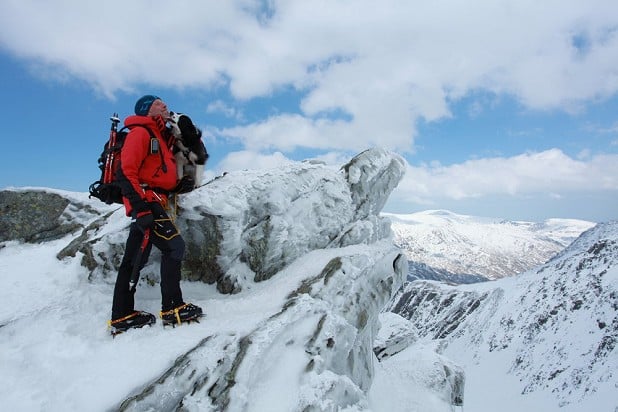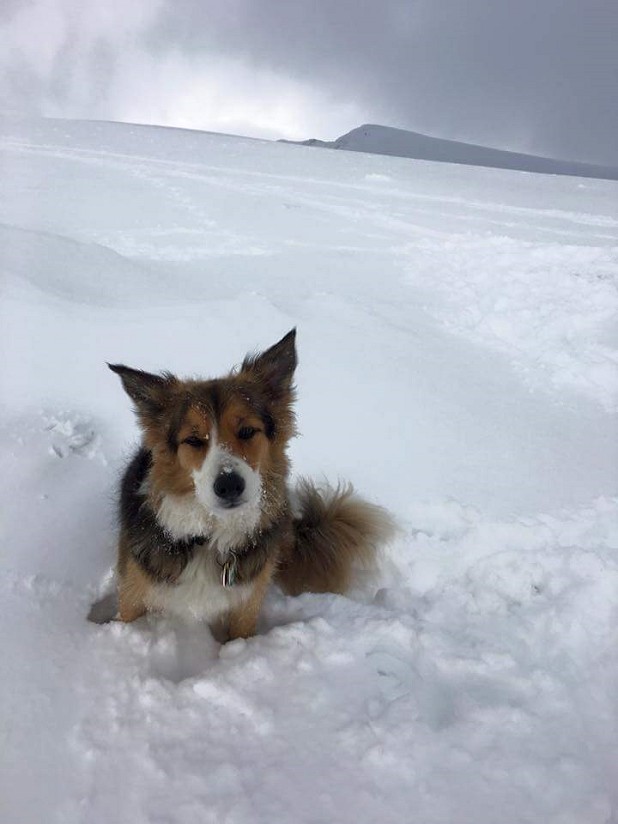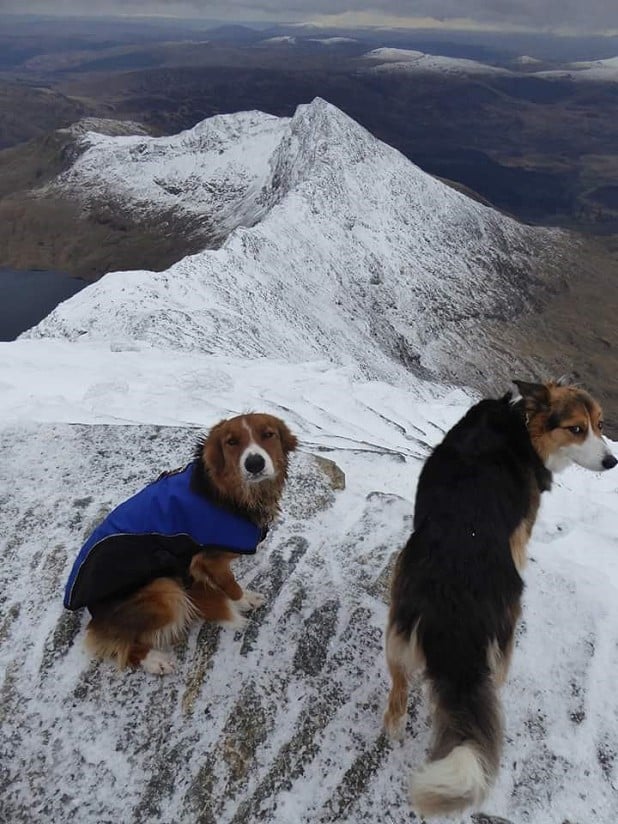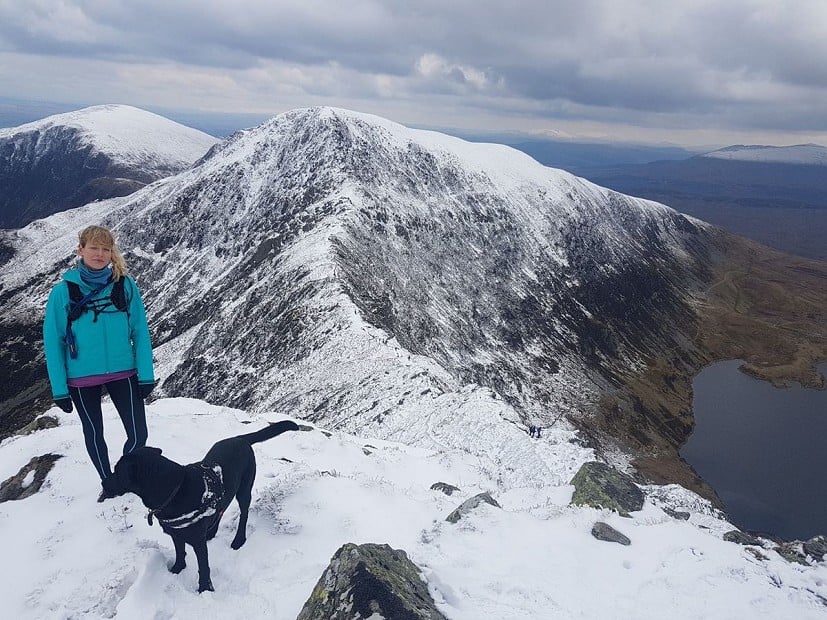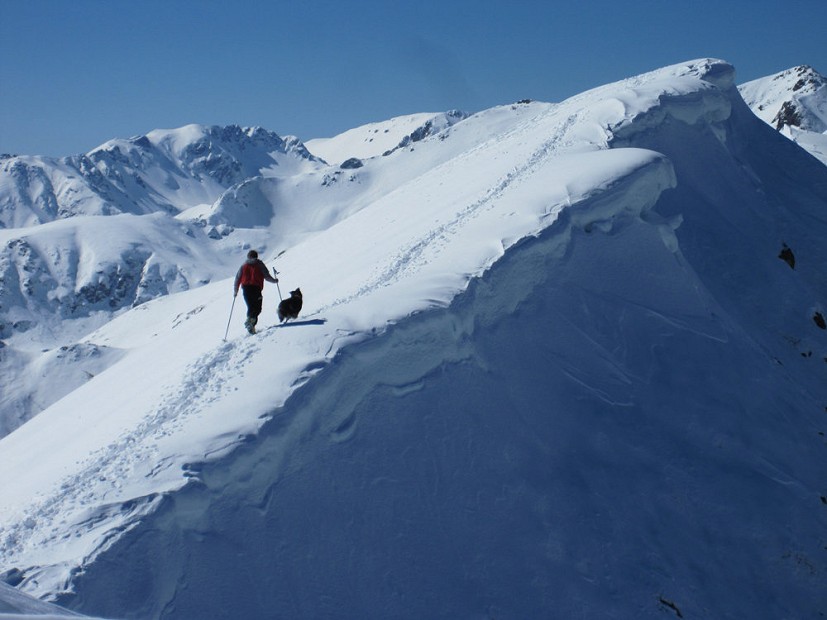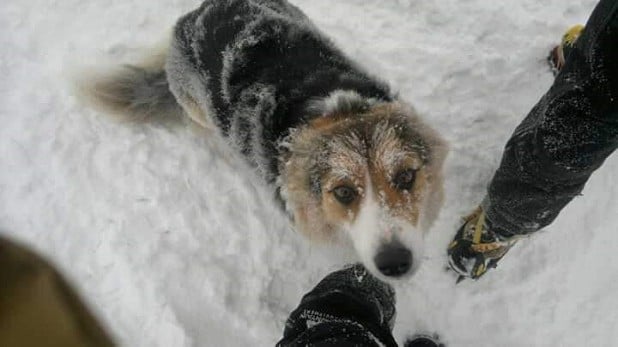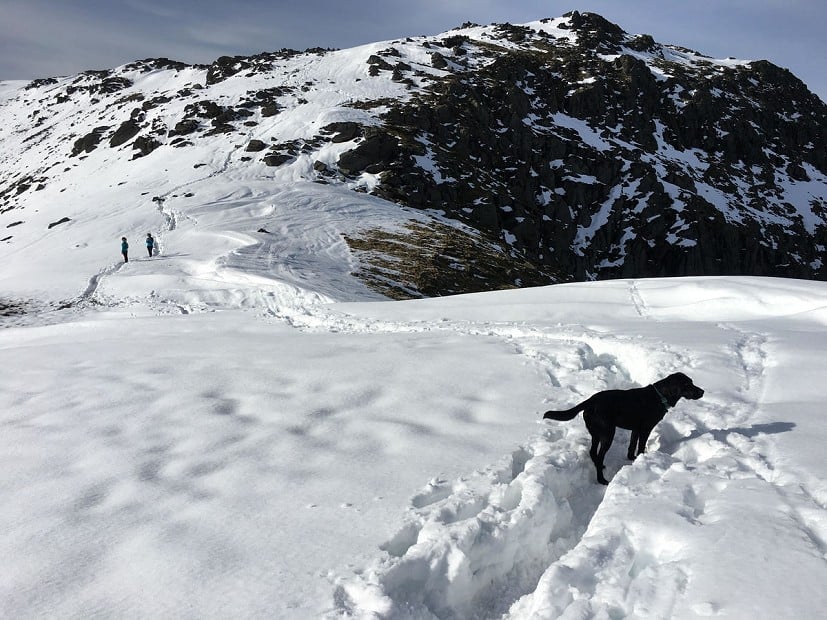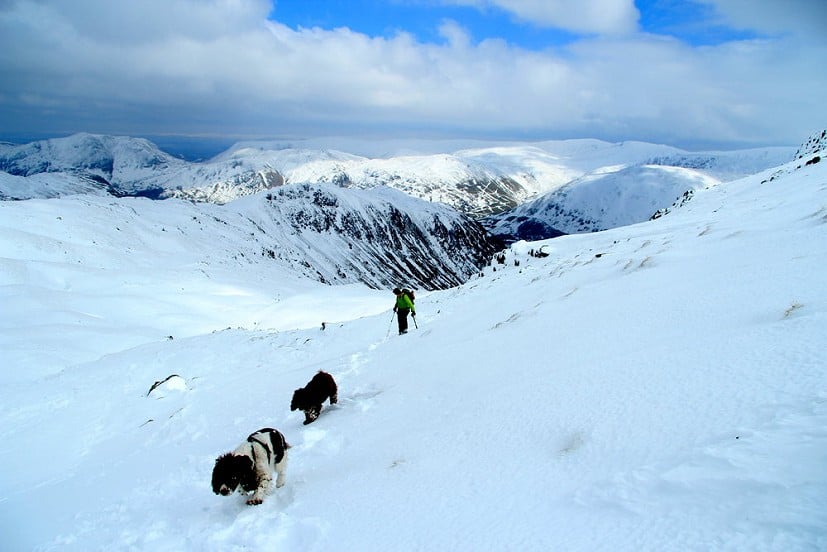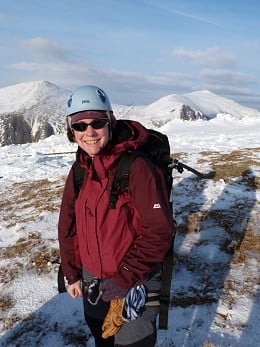Winter Walking With Your Dog
Mountain Rescue dog handler and first aid expert Helen Howe knows a thing or two about taking dogs up snowy hills. Here she shares some hard-won advice...
There is nothing better than going for a winter mountain walk with your dog. Dogs love the snow and there is no reason why your four-pawed friend can't head up into the mountains with you, in winter as well as summer, so long as you take into account the weather and the conditions and are prepared to make some concessions. Just remember that in the winter mountains things can go wrong for dogs just as much as for humans, as the sad tale of border collie Meg, who died on Beinn Sgulaird in January this year, shows. So here are some top tips for safe, happy winter dog walks.
Not all snow is the same
Snow comes in a huge range of types and textures, from soft, wet and heavy through deep and powdery to hard-frozen neve.
Wet, soft snow is awkward for dogs and they can sink into it if it is deep. This is especially tiring for a smaller dog and even for larger dogs if they are having to bound or jump for each step. Dogs with longer coats may also get balled up. This can happen anywhere their coat is longer such as around the ruff or neck, the back quarters and also between toes. One good way of dealing with the paws is to use wax or grease, e.g. Musher's Secret, on the feet. I also use the adze of my ice axe to break up the large snowballs on the hind quarters and around the ruff. We also 'winterise' our dogs ready for the snow by clipping the hair between their toes and the longer hair on the back quarters so there is less for the snow to grip to.

Although this type of snow is more grippy and so dogs are less likely to slip, wet snow is also more debilitating for a dog through the day as it will melt on the fur, and wet dogs are tired dogs. It is very noticeable how much more tired my dogs are when the weather is either raining and windy, or wet snow and windy. Three hours of walking in those conditions can leave the dogs as tired as an eight hour mountain walk in good weather. A waterproof jacket is a must if you are out in the worst conditions.
Icy snow, or bullet hard neve made from repeated top layer thawing in the sun and hard freezing overnight, is slippery for dogs as it it for humans. It is really easy to be blasé about dogs having four paws all armed with micro spikes and crampon-like claws, but their claws are not sharp or long enough to penetrate ice and neve like crampon spikes, and dogs can take slides every bit as easily as a human. It is easier for dogs to go uphill on step icy snow than down or across, so take this into account with your route choice.
Back in 2013 I was walking on Snowdon and until we reached the Clogwyn Coch area had not really been worried about my dog. My companion and I saw some people struggling on the notorious section of the railway line where several people have fallen to their deaths, so we started heading down the slope to go to their aid. To my horror, my dog Cluanie ran past me and then couldn't stop. Fortunately I managed to run faster and get below her to stop her slide. Since then I have been far more aware of the snow conditions and it has made me choose routes with care. On some days in some softer snow conditions even a Grade I winter gully such as Parsley Fern may be fine for the right dog; on another day when it is bullet hard neve, definitely not!
Cornices
I would love to say that dogs have a sixth sense where cornices are concerned, but some seem drawn towards edges. There have been several occasions where dogs have fallen through cornices and although they may survive, there is also a high chance that they may not.
Keep your dog under control near snow edges and cornices, and be alert for them heading over to the snow on days where old cornice-remains line corrie back walls. If necessary, use a dog harness and a short length of rope to keep them safe. We will also do this on dodgy steep ground. Ruffwear make a decent dog harness. It saves messing around with a short lead and your dog getting under your feet (and crampons) on nasty ground.
Hypothermia and dogs
Dogs do get hypothermia and, just like humans, one of the first signs is shivering. Act at this point to prevent it getting to a stage where the dog is tired, lethargic and will need carrying off the hill. Dry your dog as much as possible and get a warm jacket on your it (hopefully from reading this article you will see the need for taking a dog jacket with you). If you haven't got a dog jacket then stop, put up a group shelter, wrap your pal up in one of your jackets, or a Blizzard Survival jacket, and give food and warm drink if your dog will take it. If you have a water bottle and a flask pour some of the hot drink into the bottle and wrap it in something to stop it burning the dog. Place this improvised hot water bottle inside the insulating layer. Hopefully after a while the your dog should begin to warm up and you can get on your way and down to safety.
Although dogs can get frostbite, I have not known any of our mountain rescue dogs getting it in the UK even in bad winters. This is not to say it isn't possible but if a dog is used to walking and the cold it probably has tougher pads. If you are at all concerned, get your dog checked with the vet ASAP and do not rub to warm the area.
All dogs are different. We have two collies, one with a longer, thicker rug of a coat. Most of the time in winter she does not need to wear a jacket as her own coat does a fine job of insulating her, unless it is a wet day. The younger one has a thin, short coat and feels the cold. She needs to wear a jacket most of the time in colder weather, even when it is a dry and crisp day.
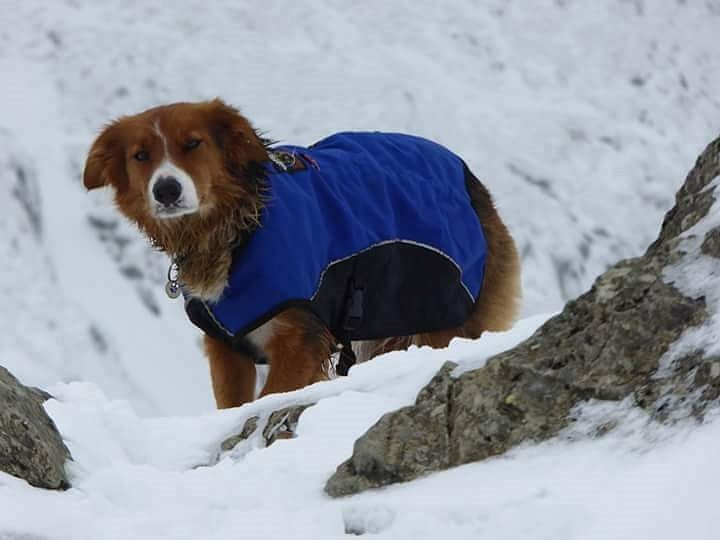
Windchill
This affects dogs as much as humans and as I have said above, dogs can sometimes get hypothermia. A good dog-coat is a must in winter for some dogs. Ruffwear and Hurtta make excellent warm coats. The best type have a waterproof outer with a warm, fleecy inner for insulation.
Food! Just as humans burn more calories in winter to stave off the cold, so do our canine companions. We always carry a bag of extra food for the dogs (something like Hi-life Complete Dry dog food Moist Mince, a dry but chewy food which is easy for woofs to wolf down).
Winter equipment
Dogs and crampon spikes do not go together, and they can end up with some really nasty injuries from a spike through a paw. A few winters ago Llanberis Mountain Rescue Team went out to rescue a dog who had a hole in its paw due to a crampon spike. The owners had tried (and succeeded) to carry it most of the way down Snowdon but in the end had to call for help. The team were only too happy to help as a lot of us are animal lovers and we have a team member who is also a vet. The dog's paw was patched up and she was able to walk off under her own steam. Mission accomplished!
Be very aware of your dog and do not step backwards without looking first to check where your dog is! Icy snow can occasionally also slice dogs' pads so if your hound looks tender, check out the paws.
It is worth carrying a first aid kit specifically for your dog with items such as Soft Ban, Vet Wrap, and dog boots/socks to patch up and protect any wounds which occur. But be aware that it is also very easy to cause nasty pressure points on your dog's paws so do not dress too tightly.
At the end of the day...
After a big day out dogs can become stiff just like us humans, so make sure you towel your dog off and then wrap them up in a jacket to wick any damp away. Ruffwear produce a fantastic jacket, the Fernie which wraps under the dog's belly as well as around the chest area. It wicks the wet away leaving your dog warm and dry. You will have a happy, contented and tired hound wuffling gently to itself as it snoozes in front of a warm fire.
So in summary:
- Carry extra food for your dog
- Be prepared to change your route and plans if the snow is too steep, slippery, hard or deep for your dog
- Remember dogs can suffer from the cold including hypothermia and frostbite so keep checking them through the day
- Carry a dog jacket or coat
- Each dog is different so do not presume what works for one will work for another
- Carry a group shelter and emergency equipment so if you or your dog become immobile you can take shelter
- Have some specific canine First Aid items in your first aid kit.
About Helen Howe
Helen runs Snowdonia First Aid with her husband Steve.
Each have over twenty years of Scottish winters and are qualified Winter and International Mountain Leaders. They run Outdoor First Aid courses and Mountain Leader Training and Assessments as well as mountain and hill skills courses. This winter Helen and Steve are running Winter Skills courses both in Snowdonia and Scotland.
Both she and Steve are active members of Llanberis Mountain Rescue Team and have served on the Medical and Training Sub committees running some of the team's winter training.
Helen has been a Mountain Rescue Dog handler since 1995, and has trained three SARDA dogs. Her current dog Cluanie is her third.
